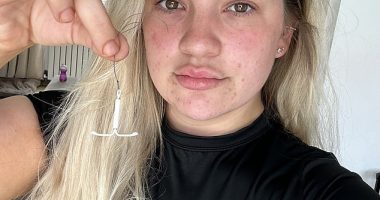Lately, every time you look in the mirror, your eyes fix on the tiny tangle of red lines branching out across your cheeks and around your nose. And you wonder, what the heck are these things? More often than not, those red, spider-like clusters are just…broken blood vessels.
Broken blood vessels are overgrowths of capillaries—i.e., small blood vessels, says Joshua Zeichner, MD, director of cosmetic and clinical research in dermatology at Mount Sinai Hospital in New York City. They tend to form when capillaries just under your skin weaken and dilate, and they can develop on other parts of the body like the neck, chest, or even the legs (known as spider veins), he adds.
Experts In This Article
- Joshua Zeichner, MD, director of cosmetic and clinical research in dermatology and associate professor of dermatology at Mount Sinai Hospital
While broken blood vessels can pop up on anyone’s face, they “typically develop in people with more fair skin,” says Dr. Zeichner. In most cases, they’re completely harmless. But if they bother you, you do have options.
Read on to learn what causes broken blood vessels on your face, plus how to prevent and treat them.
In This Article
Causes of broken blood vessels on your face

Broken blood vessels can affect anyone, but certain factors might make you more likely to develop them on your face, specifically. These include:
1. Genetics
It’s possible you can blame your DNA for the broken blood vessels on your cheeks and nose. As Dr. Zeichner mentioned, people with fair skin are prone to broken capillaries. And those with a history of skin conditions like rosacea (more on this in a sec) are also more likely to develop broken facial capillaries, he adds.
2. Rosacea or other skin conditions
Rosacea might be the reason for your broken blood vessels. This common inflammatory skin condition causes redness on your face, and those who have it tend to develop broken capillaries, too, which look like small, red lines on the skin, says Dr. Zeichner.
Certain things can cause rosacea flares and make the broken blood vessels more visible. “In rosacea, blood vessels are overreactive, which leads to excessive dilation in response to triggers like spicy food, alcohol, hot beverages, and even emotional stress,” he says. “Over time, this leads to permanent facial flushing.”
3. Sun exposure
Yet another way the sun can harm your skin if you don’t wear SPF every day. “UV light exposure causes damage to collagen and elastic fibers and promotes development of new blood vessels,” adds Dr. Zeichner.
4. Alcohol consumption
Sorry to say, but sipping on your favorite cocktail may be causing broken blood vessels on your face. Not only does alcohol cause existing blood vessels to dilate (read: get bigger and appear more noticeable), but it also promotes the development of new capillaries, says Dr. Zeichner.
5. Post-surgery
If you’ve recently noticed broken blood vessels after a surgical procedure, there’s a good reason. “As part of a wound healing response, the skin produces new collagen and blood vessels as the skin repairs itself,” says Dr. Zeichner. This may be why after certain facial procedures, you notice more broken capillaries on your face.
6. Straining
Any time you strain (think: crying, sneezing, vomiting, pushing on the toilet, or even having a seizure), it can put “increased pressure in the face,” says Dr. Zeichner. And “this can cause capillaries to leak.”
While these tiny red, brown, or purplish spots of bleeding under the skin (called petechiae) might resemble broken blood vessels, they’re not quite the same thing. The former are leaky capillaries that form little bruises while the latter are overgrowths of new blood vessels, says Dr. Zeichner.
If you have petechiae along with other symptoms of illness, reach out to your doctor. You may have an underlying condition that needs treatment with antibiotics, supplements, or other medications, per the Cleveland Clinic.
7. Pregnancy and giving birth
Hormonal changes during pregnancy can bring on broken blood vessels on your face. High estrogen levels “encourage the development of broken capillaries,” says Dr. Zeichner. On top of this, if you strain to push during birth (hello, it’s hard work!), you might see a bunch of “popped” blood vessels on your face. Again, these aren’t new capillaries forming but rather the ones you already have bleeding under the skin (causing temporary bruising).
8. Aging
The older you get, the more likely you’ll have broken blood vessels on your face. Usually, you see more broken capillaries with age because environmental exposures (like UV light damage) and other types of chronic low-grade trauma to your skin (think: persistently picking at zits) add up over time, says Dr. Zeichner. In other words, it’s a cumulative effect.
Do broken blood vessels on your face heal?
Hate to break it to you, but “once they develop, new capillaries are usually permanent,” says Dr. Zeichner. On the bright side, if they bother you, there are ways to make them less visible (more on this later).
Unlike broken blood vessels, leaky capillaries that cause facial bruising (i.e., petechiae from activities like crying, puking, or straining on the toilet) are only temporary, says Dr. Zeichner. They usually fade away on their own and don’t require any treatment.
How to treat broken blood vessels on the face
To get rid of broken blood vessels on your face for good, you’ll likely need to visit your dermatologist. “Unfortunately, the only way to truly treat broken capillaries is to use a physical modality like a laser,” says Dr. Zeichner. Laser therapy is a noninvasive procedure that uses light to remove the damaged blood vessels (without harming or scarring your skin). Smaller capillaries may go poof! right away while larger clusters may take up to three months to fade (or even require multiple sessions), according to the Cleveland Clinic.
Sadly, laser therapy can be pricey (especially because it’s not typically covered by insurance). Fortunately, there are more affordable things you can do at home to minimize the appearance of broken blood vessels on your face, which include the following:
- Moisturizing: Keeping the skin barrier in good shape will help maintain skin hydration and reduce inflammation, Dr. Zeichner says. Try to apply lotion to your face every day.
- Drinking water: Hydrated skin happens from the inside out, so sipping on H2O throughout the day may help your skin cells stay properly hydrated and elastic, per an August 2018 review in Skin Research and Technology.
- Applying a retinol cream: While not as effective as laser therapy, the best cream for broken blood vessels on the face is over-the-counter retinol. It can make broken blood vessels less visible on your face by plumping up the skin, and promoting the production of collagen, per the Cleveland Clinic. Bonus if the product has hydrating ingredients like hyaluronic or lactic acid, too.
How to prevent broken blood vessels
While you can’t always prevent broken capillaries from spreading on your face, you can lower your risk. Here’s how, according to Dr. Zeichner:
- Use a daily moisturizer to maintain a healthy, well-hydrated skin barrier.
- Wear sunscreen daily (with SPF 30 or more) to protect yourself from UV light exposure.
- Limit triggers that lead to facial flushing, like spicy foods, emotional stress, alcohol, and hot beverages
- Drink plenty of water.
When to see a doctor
Though you might not love the way they look, broken blood vessels are usually harmless. But if you have new clusters of capillaries accompanied by other symptoms, you could be dealing with a more serious skin or medical problem, Dr. Zeichner says. For example:
- If you have small, red bumps, pus-filled pimples, or burning and stinging in the face along with facial redness, you may have rosacea.
- If you have facial redness around the nose and the cheeks, along with sensitivity to UV light, and joint aches, these can be signs of an autoimmune condition like lupus.
If you have any of the above symptoms, talk to your dermatologist. They can help diagnose the underlying issue, discuss treatment options, and, if necessary, refer you to another specialist.
FAQ
What else causes redness on your face?
We’ve learned that broken blood vessels and rosacea can make your face flushed and red. But these issues are only the tip of the iceberg when it comes to facial redness. There are many other reasons why your face might be rosy. These include the following, per the American Academy of Dermatology Association (AAD):
- Seborrheic dermatitis: A common skin condition that causes a red rash, which often appears on the face, as well as oily, dry, and scaly skin
- Contact dermatitis: A condition that develops when something that touches your skin irritates it or causes an allergic reaction
- Reaction to a medication: For example, some medications can cause a sunburn-like reaction with sun exposure
- Atopic dermatitis (i.e., eczema): A skin condition that can cause a red rash that’s dry, scaly, and itchy
- Psoriasis: A condition that causes the body to make new skin cells more quickly than normal, resulting in raised, scaly patches
- Shingles: A condition that causes a painful, blistering rash, which can appear anywhere on your skin, including your face
- Lupus: An autoimmune disease that can cause redness and swelling on the skin, and, sometimes, a facial rash that’s shaped like a butterfly across your nose and cheeks
- Sézary syndrome: A rare form of cancer that begins in a type of white blood cells called the T-lymphocytes or T-cells, which are plentiful in the skin
If your facial redness hasn’t gone away on its own in two weeks, see your dermatologist. A proper diagnosis is important because there are so many conditions (some potentially serious) that can make your face red, per the AAD.
What causes broken capillaries on a child’s face?
While broken blood capillaries are more common in older folks, anyone can get them on their face, including kids. Like adults, children may be more susceptible to these small, spider-like red blood vessels thanks to their genes and environmental factors (like excessive UV exposure), according to the Nicklaus Children’s Hospital. Luckily, these little red lines on the face are no big deal, as they’re usually harmless to your child’s health. But of course, reach out to a pediatrician if you have concerns.
What causes broken capillaries on legs?
Broken capillaries on the legs—also called spider veins—happen when the tiny blood vessels close to the skin’s surface get weak and swell. Though it’s not totally clear why this happens, some possible reasons include the following, per the Cleveland Clinic:
- Hormonal changes
- Genetic syndromes
- Connective tissue diseases
- Injury or trauma
You’re also more likely to develop broken capillaries on your legs if you have the following risk factors, according to the Cleveland Clinic:
- You stand or sit for long amounts of time
- You have close biological family members with spider veins or varicose veins
- You have obesity
- You’re pregnant
- You use hormonal birth control
- You use hormone therapy for menopause symptoms
- You spend a lot of time in the sun
- You smoke (or used to smoke)
Well+Good articles reference scientific, reliable, recent, robust studies to back up the information we share. You can trust us along your wellness journey.
- Akdeniz, M et al. “Does dietary fluid intake affect skin hydration in healthy humans? A systematic literature review.” Skin research and technology : official journal of International Society for Bioengineering and the Skin (ISBS) [and] International Society for Digital Imaging of Skin (ISDIS) [and] International Society for Skin Imaging (ISSI) vol. 24,3 (2018): 459-465. doi:10.1111/srt.12454
Source: Well and Good






